Software Code Audit — Processes Breakdown, Tools and Statistics


According to statistics, roughly 20% of bugs remain undetected. Hence, they get passed to the release environment and discovered by end users.
The cost of fixing errors on live apps is many times higher than finding and fixing bugs in the testing environment. Therefore, many product owners decide to audit code to enhance a product’s quality and spend the budget effectively.
A source code audit implies many crucial stages that help improve a digital product, fix vulnerabilities, increase performance, etc. The software code audit can be applied to any digital application, including websites, mobile apps, and desktop software.
In the post below, we’ll untangle the code auditing process and share helpful hints to decrease the number of bugs and mistakes in your future products.
What is a software code audit?
The source code audit is the process of running tests and manual codebase inspection to detect bugs. Besides, software engineers find pieces of code that can be improved.
Top-tier code auditing services don’t focus on codebase inspection. Skilled experts analyze the architecture of an app, check technologies used, examine environments, and many other details.
The primary outcome of a code audit is a detailed report highlighting issues needed to solve and recommendations on how to improve a product. Also, it may imply the best practices and instructions on how to fix problems and enhance a digital solution.
Source Code Audit Benefits
App code inspection helps product owners improve their solutions, verify top-tier quality, fix issues, achieve business goals, etc.
Code auditing can help:
- detect bugs and undefined security vulnerabilities
- decrease downtime caused by unforeseen technical issues
- define options to improve your digital product
- get a report to verify a product’s technical excellence
- discover if source code programming standards are met
- make software maintenance stress-free
- adopt the latest technologies
- ensure that software can scale up and tackle extensive workload
- improve the quality of code
- improve software development and release processes
How software code audit works
How does the source code analysis work? Let’s break down the workflow and review all the processes in more detail.
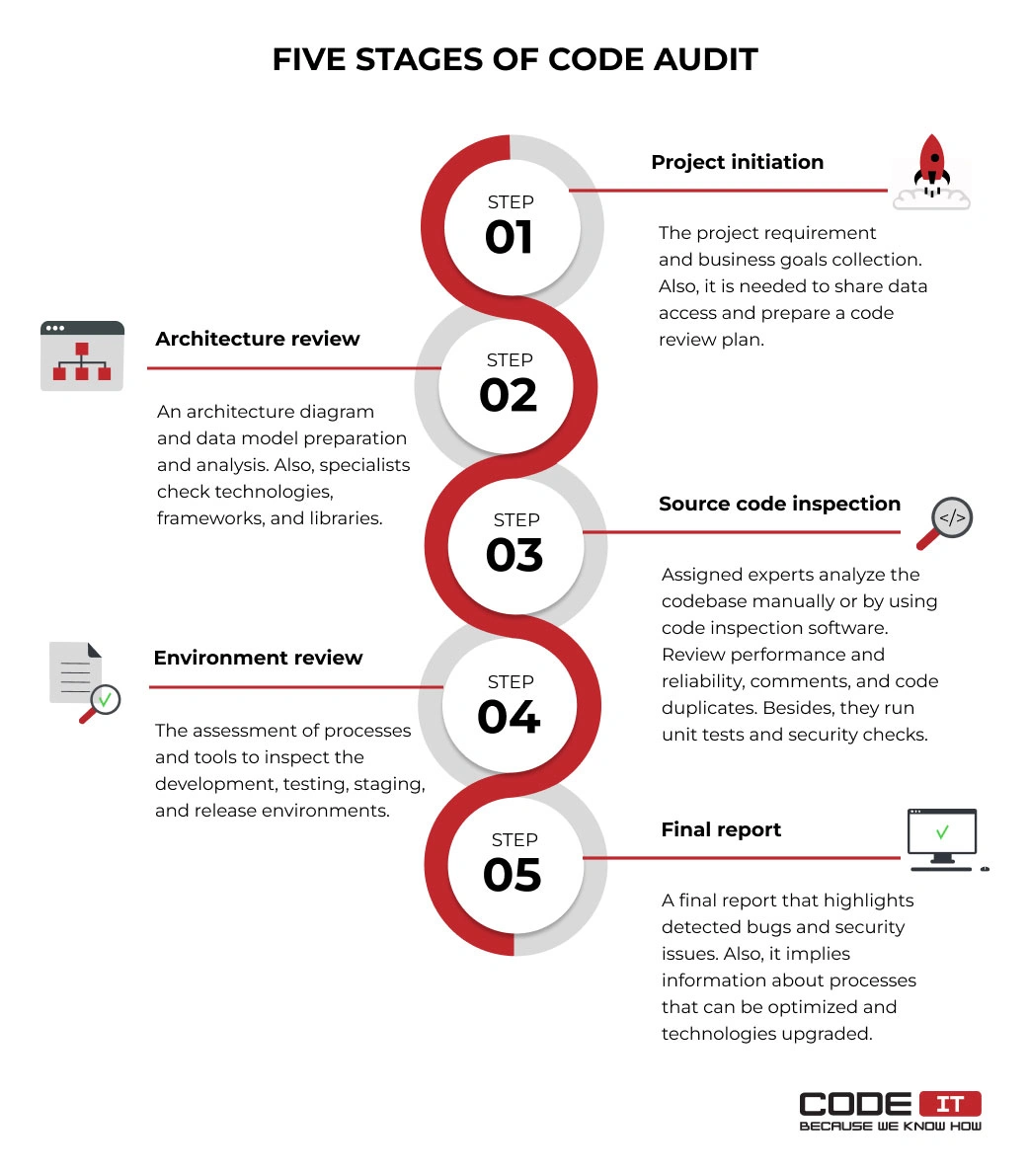
Depending on a client’s needs, the source code audit workflow may imply different stages. The five crucial stages are the following:
1. Project Initiation
The project initiation stage helps define goals that clients want to achieve to develop a personalized code audition plan.

The project initiation steps are:
Introduction call
A kick-off meeting with representatives of an external agency to share information about a project to initiate software code audit services.
Requirements and goals definition
The clients should share information about current problems with software and goals to achieve. All the information can be shared during a one-a-one meeting or by submitting a questionnaire.
Access credentials and internal data sharing
A product owner should grant access to all the files and services so that hired engineers can inspect the source code. Usually, it’s required to share the following:
- files with source code
- access to a repository
- login credentials to additional services
- access to servers
The list of data that should be shared can vary, depending on the type of software checked and the goals specified by the product owner. To conduct a deeper code auditing analysis, you may be required to share the following:
- internal documents and guides for employees
- information about your product development workflow and project development tools
- UI/UX design standards and templates
- information about code analysis tools and processes
Code analysis plan preparation
Hired experts analyze all the information a product owner provides and prepare a personalized code analysis plan. It helps involved experts focus on the key issues and goals aimed to achieve.
Non-Disclosure Agreement
Since external software analysis experts are involved, it’s vital to ensure that no internal data won’t be exposed.
We recommend preparing and signing a non-disclosure agreement (NDA) with a source code auditing agency. Ensure that a hired third party will keep all the received information and data access credentials safe.
2. Architecture Review
Architecture review is the high-level analysis of inspected software. Hired specialists conduct it to understand how an application works and what technologies are used. The architecture review involves the following activities.

Architecture diagram creation and analysis
Assigned specialists thoroughly review an application’s architecture and prepare a diagram highlighting all the details. It helps outline all the components of an application and how they interact with each other.
If an application has the microservices architecture, it’s recommended to develop different architecture diagrams for every microservice separately.
Experts highlight critical issues that should be resolved and offer the best solutions to implement. Also, they can suggest an app’s architecture improvements to achieve the goals set.
Data model creation and analysis
Data modeling and analysis help understand how data is generated, stored, shared, updated, and deleted. Experts analyze the data flow to detect possible security issues. Also, it helps understand how the performance of an application and databases can be improved.
Technologies and frameworks review
Code auditing experts thoroughly examine all the technologies and frameworks used to develop the examined software. Also, assigned experts define if switching to other technologies and frameworks can help achieve the specified business goals.
Libraries review
Libraries provide developers with access to pre-written pieces of code. These days, there are tons of libraries that software engineers select to create certain functionality.
Software architects analyze the selected libraries to discover if there are better alternatives to choose from. Besides, they check if the latest versions of libraries are installed.
For instance, there are many email validation libraries. If the library selected by a developer does not cover all the incorrect email input cases, it should be replaced with a more advanced alternative.
3. Source Code Inspection
At this stage, experts should thoroughly inspect an app’s codebase manually or using digital tools. It’s required to define the programming language used in an app’s codebase and assign the tech experts with the required expertise to the project.
There are many different approaches applied to inspect codebases. The most effective one is to use the combination of digital tools and manual code inspection.
The front-end and back-end code inspections should be conducted separately.
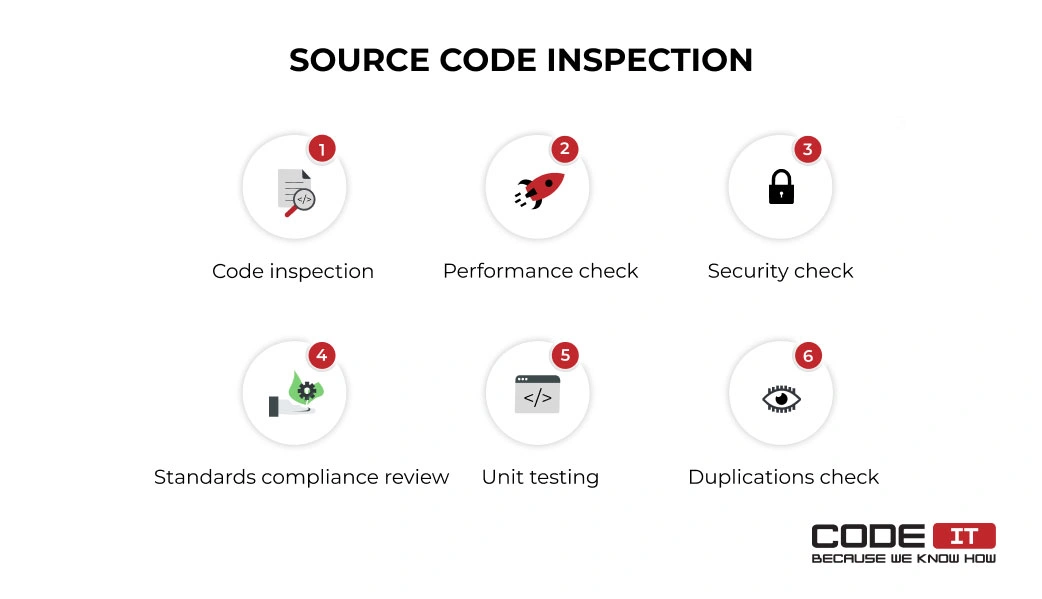
Usually, the source code inspection involves the following stages.
Code inspection tools application
The codebases of modern applications can imply hundreds of thousands of code lines and more. For instance, the codebase of the iOS Uber app implies several millions of lines of code. It may be a daunting and time-consuming task to inspect every code line manually.
Hence, developers use different software to analyze codebases. Digital code auditing solutions run static code analysis and mark suspicious pieces of code that tech experts should review in more detail. Tech-strong specialists analyze all the checkpoints and decide whether they should be updated when completing a software code audit service.
The most popular code review tools are:
Benefits of Automation Testing
Performance and reliability check
Reliable software can run code fail-free in a given environment. The reliability check may involve both static and dynamic code analysis. Developers can inspect static code manually or run it and observe the outcomes.
Also, they provide an extensive load to the software to discover if it can scale and work fast in a changing environment. Source code auditing helps define possible performance flaws to make an app work fast and fail-free.
Security check
Almost every technology used to develop applications have certain vulnerabilities and loopholes that can be used by attackers or malicious software.
For instance, SQL injection is one of the most widespread techniques used by hackers to access databases and their data. Poorly composed software may confuse input data with a command, providing unauthorized access to a database. This vulnerability should be fixed by software engineers when building a new product. Otherwise, the database can be easily accessed and destroyed by hackers.
Cyber security specialists thoroughly examine the codebase to find any possible loopholes. With the help of vulnerability assessment, software engineers can detect and fix potential exploits.
The most popular vulnerabilities are:
- Code Injection
- Cross-site Scripting
- Broken Session Management
- Security Misconfiguration
- Hard-coded Login Credentials
Cyber security experts conduct penetration testing, which is an ethical hacking testing approach. They simulate spear attacks on a system to define possible security issues that need to be addressed.
Database Security Best Practices
Comments and quality standards compliance review
Other developers can easily explore a well-commented code to update it or develop new features. Hence, developers discover if the code complies with the established style and quality standards.
Software code audit experts analyze comments’ quality, readability, and relevance in the reviewed codebase. The comments coverage is represented in percentages.
Unit testing
Unit testing is the software testing approach that needs software engineers to isolate the smallest pieces of code, called units, and inspect them. In short, developers put an app apart and test all the parts separately. Unit testing facilitates debugging because bugs can be quickly allocated and resolved.
Duplications check
Tech experts analyze the codebase and all the files to find any code or lines duplicates. They can specify the code duplication percentage in the final report and specify duplicated strings or files detected.
4. Environment Review
An environment in software engineering is a combination of tools, services, and processes that developers use when building, testing, and releasing software.
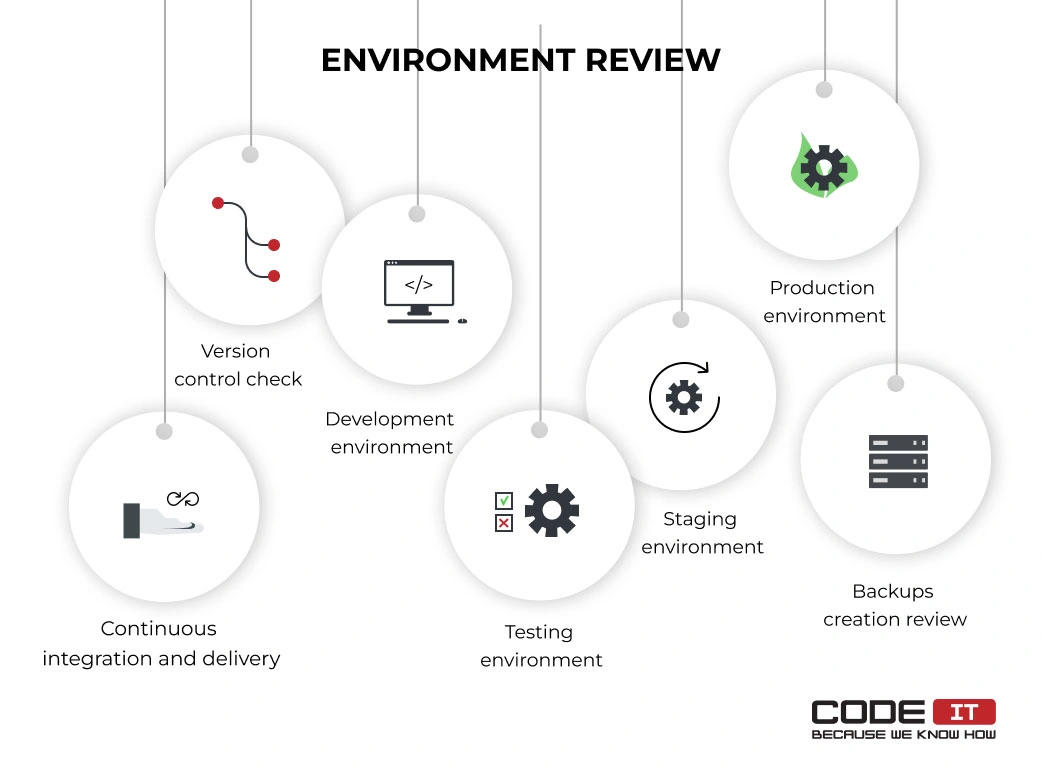
Version control
Software engineering analyzes all the repositories and the process of uploading new code files to the main branch. If any issues or possible improvements in the process are detected, they are specified in the final software code audit service report.
The version control helps software engineers better track all the changes and revert them if needed. Also, it helps protect the source code from harmful changes that may be conducted by developers.
Development environment
The development environment foresees the opportunity for software engineers to build new features. Assigned specialists analyze tools and processes used by developers to create new digital solutions.
Testing environment
Insufficient testing can lead to poor product quality, critical bugs, and other issues.
A senior software test engineer is involved in inspecting the following:
- manual and automatic testing processes
- code review process
- regression testing availability
- load testing processes
The involved specialist provides a report on the reviewed testing tools and processes, highlighting what should be optimized or automated.
Staging environment
The staging environment is a dedicated sandbox that simulates the production environment. It helps software engineers experiment with the code without affecting the live product.
Production environment
The production environment contains the latest product version with which end users can interact. Assigned code auditing experts analyze its structure, connected services, automatic backup configuration, maintenance cost, etc.
Continuous integration and continuous delivery
The CI/CD helps automate the process of building, testing, and deploying a product to increase efficiency. Assigned DevOps experts review all the processes to offer optimization options.
Backups
Source code auditing experts discover if the automatic backup creation is configured correctly. They assess the frequency of product backup creation. Also, they examine the data restoration and synchronization processes.
5. Final Report
The final report implies all the information about detected bugs and vulnerabilities and processes that can be optimized. All the issues detected are categorized as critical and non-essential.
The document implies suggestions on how to resolve critical issues. Also, it highlights technologies to upgrade or replace and processes to optimize.
Get your application inspected by experienced code audit specialists!

Business First
Code Next
Let’s talk
Additional technical audit actions
The source code audit may imply additional activities that help analyze its quality and improve a digital product.
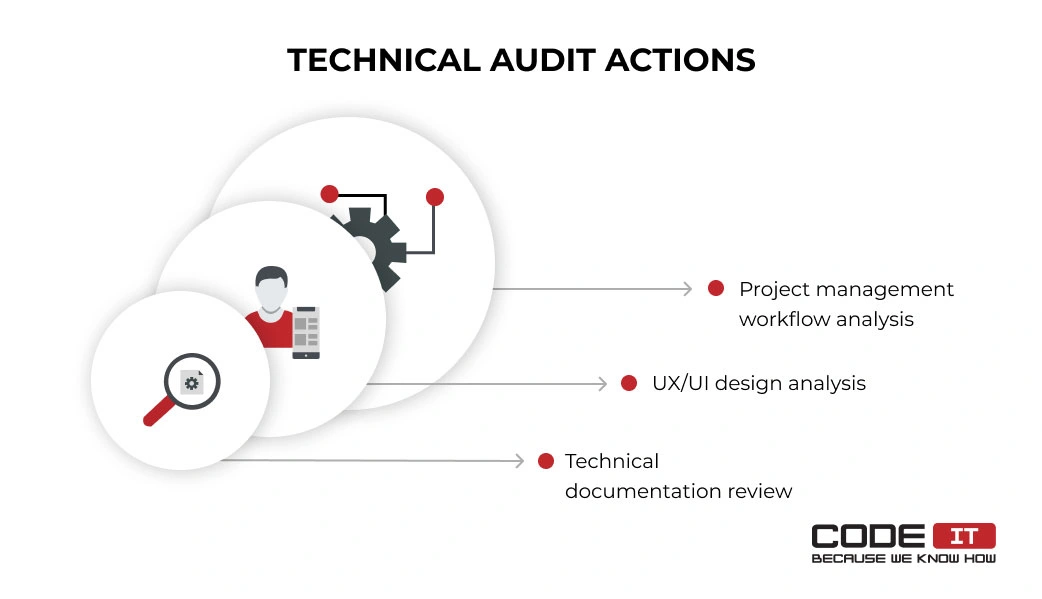
Technical Documentation Review
Technical documentation is a set of papers that describe a product and how it works.
Technical experts explore if a product is supplied with documentation and assess its quality. Besides, they analyze the internal documentation creation processes to discover if they can be optimized.
The most widespread technical documentations types are:
- Product documentation. It is internal documents that are also known as READMEs. They describe a product in more detail and how to use it.
- Process documentation. Internal instructions, also known as Wiki, help team members understand how to complete tasks and what outputs to deliver.
- API documentation. Documents that help developers understand how to integrate third-party services into the software using API.
- Software Development Kit (SDK) documentation. Internal documents on tools and technologies to use when developing a product.
UX/UI Design Analysis
A dedicated user experience/user interface (UX/UI) expert is involved in analyzing the visual part of the application that end users interact with.
An expert reviews business goals and examines the UX/UI to discover any possible issues and suggest improvements.
For instance, a confusing user interface may negatively affect the conversion rate. High content loading speed may lead to an increased churn rate.
A detailed UX/UI analysis can help detect critical issues and discover how to optimize an app to achieve business goals specified in the software code audit project initiation stage.
Project Management Workflow Analysis
The meticulous analysis of the internal project management process can help increase the efficiency of software development teams. Also, project management optimization can positively affect the product’s quality.
A senior project manager examines the following processes.
- Scope management. A backlog of tasks for software engineers for one iteration or more, deliverables, acceptance criteria, change log, etc.
- Schedule management. A detailed product development schedule approved by stakeholders. It should imply the duration of every task and the resources allocated to complete it.
- Communications management. A communication plan with defined roles and action items creation process.
- Risk management. A set of possible risks and response actions to mitigate unforeseen issues that may occur.
- Team management. Team administration, engagement, and coordination processes.
- Artifacts management. The process and tools used to store, update, and share all the internal documents, files, etc.
- Process management. The detailed product development and release flow. Also, it implies engineering practices and standards compliance.
Need a complete technical audit of your application?

Business First
Code Next
Let’s talk
CodeIT expertise in source code auditing
The CodeIT team has vast experience in inspecting codebases. We have completed many successful projects.
Our specialists thoroughly examine the codebases comprising many different services written in distinctive programming languages and assess the technologies used.
Feel free to learn more about our two software code audit case studies below.
Comprehensive Technology Audit And Code Review
A client requested us to provide expert-grade technology advisory services and a code audit.
Our experts inspected an application to define its architecture, data flow, technologies used, etc. Also, they have performed the codebase analysis. We managed to find a lot of bugs and critical issues caused by the use of outdated technologies.
After receiving the report with expert suggestions, the client decided to use more innovative technologies, updating the entire codebase.
The clients have hired our software engineers to implement all the changes quickly and hassle-free.
Detailed Codebase Analysis
Striving to achieve better performance and get cleaner code, a client requested us to examine the codebase of an application.
After defining business requirements, we have allocated a team of tech-strong experts with the required expertise to inspect the code.
Our specialists have detected bugs missed by the client’s in-house QA team. Also, they have prepared a report highlighting the best options to optimize the code.
The client reviewed the code audit report and hired our team to improve the application. We have conducted code refactoring to optimize the codebase. No features were changed or removed.
Code audit statistics
Poorly composed code leads to increased product development time and budget. Also, it negatively affects customer experience and sales. Let’s take a deeper dive by exploring the code audit statistics.
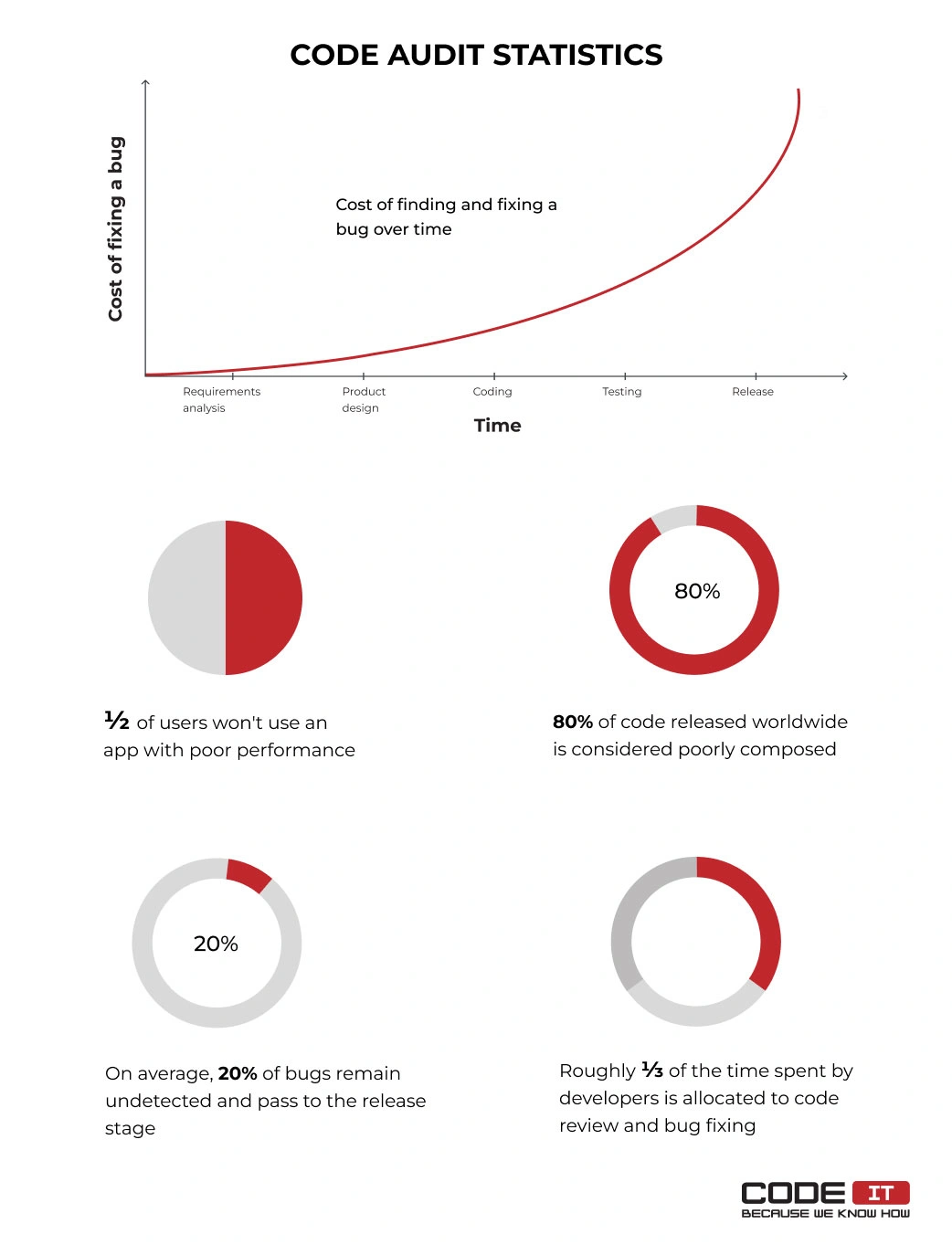
Early bug detection helps save the budget. It’s much cheaper to find and fix bugs in the development and testing stages.
Let’s check more software code audit statistics below.
- Roughly 1/2 of users won’t use an app if it has poor performance
- About 80% of the code composed worldwide doesn’t match the good or excellent quality standards
- Up to 20% of bugs remain undiscovered and pass to the production stage
- Roughly 1/3 of the time spent by developers is allocated to code review and bug fixing
When to opt for software code audit
Source code review and bug fixing are a part of the product development process. However, business owners find the code audit services helpful in the following cases.
- The internal team lacks skills.
The existing team can hardly detect issues in developed software and fix them effectively due to poor technical expertise.
- An app doesn’t work as designed.
The developed application cannot perform the required tasks and deliver expected results, or deliverables are insufficient.
- An app should be tested to scale up.
A business owner needs to test the existing application to discover if it can be scaled up or if new functionality can be added using the same technologies and architecture.
- Business goals cannot be attained.
Business owners struggle to achieve their goals because the developed software has poor performance, too many issues to troubleshoot, etc.
- Product quality verification is required.
A product owner or potential investor hires a third-party agency to double-check it. A code auditing report helps ensure that the reviewed software matches top-quality standards.
- An app is vulnerable.
A product owner experienced data leakage because of insufficient software security. Alternatively, an application was infected by malware or failed because of a spear attack.
- The source code doesn’t match established standards.
The code developed by software engineers does not match the quality standards established by the company.
- A double-check should be performed.
A product owner does not trust the in-house CTO or a hired outsourcing agency. Hence, they want to perform an independent software code audit to avoid possible issues caused by a poorly-developed codebase.
- Product development deadlines are missed.
Increments are not delivered on time because software engineers spend a lot of time fixing critical bugs.
- An app uses outdated technologies.
The tools and technologies used to build an application are considered outdated and should be upgraded or replaced.
Key takeaways
Code auditing helps improve the quality of the codebase and technology selection. Also, a comprehensive technology audit can help define bottlenecks and management issues that negatively affect a team’s performance.
The software code audit process implies five crucial stages:
- Project initiation.
The initial stage aims to define business goals, collect the required access credentials, sign an NDA agreement, etc.
- Architecture review.
Tech experts analyze an app’s architecture, data model, technologies, and libraries.
- Source code inspection.
Assigned specialists review the codebase, conduct unit testing, run security checks, inspect comments, etc.
- Environment review.
A tech lead examines tools and processes used to develop and release an app to discover if they can be improved.
- Final report.
A document highlighting all the bugs and other issues detected with instructions for solving them. Also, it implies suggestions on optimizing the codebase and product development processes.
Additional tech audit activities may be conducted to check the UX/UI design, technical documentation, and project management workflow.
Hire top tech experts to conduct a source code audit!

Business First
Code Next
Let’s talk
FAQ
Comprehensive code audit goes beyond codebase inspection. The five steps to take are:
- Collect business goals and prepare a code analysis plan.
- Review an app’s architecture, data model, technologies, frameworks, and libraries.
- Conduct manual or automated codebase inspection. Also, run security testing, unit testing, duplicates check and review comments.
- Review development, testing, staging, and production environments.
- Prepare a final report with optimization suggestions.
The primary purpose of conducting a code audit is to detect any possible bugs, security issues, code quality standard violations, etc. An optimized codebase helps implore an application’s quality, security, and performance.
The most popular third-party tools that help analyze the code are:
- GitHub code review
- Codesonar
- Gerrit code review
- Codescene
- ReviewBoard
A detailed report is the main output of the code audit. It should imply information about bugs detected and recommendations for resolving them.
Also, the final report should imply information about options to optimize the reviewed codebase and product development process.
To get a comprehensive technical audit, feel free to conduct the following activities:
- UX/UI design analysis
- Technical documentation review
- Project management workflow analysis
The source code audit can become very helpful when your:
- internal team lacks technical skills
- app doesn’t work as designed
- app should be tested to scale up
- business goals cannot be attained
- product quality verification is required
- app vulnerabilities were exposed
- app’s source code doesn’t match established standards
- product development deadlines are missed
- app uses outdated technologies
When involving a third party to inspect the codebase, a product owner can:
- find undetected bugs and security issues
- enhance product maintenance
- ensure that an app meets the highest technical standards
- adopt the latest technologies
- optimize product development, testing, and release processes
- discover how to optimize an app’s performance and security
Build your ideal
software today







